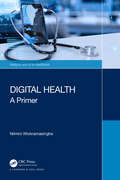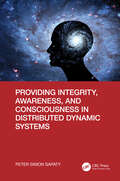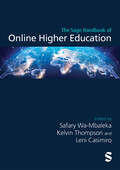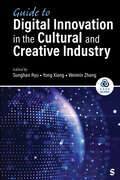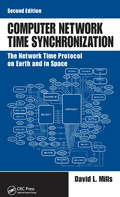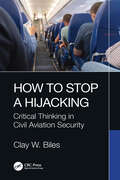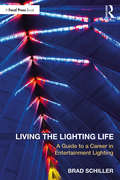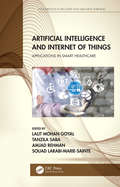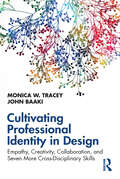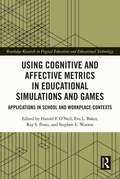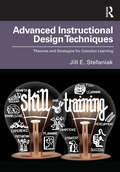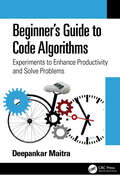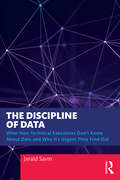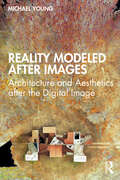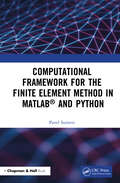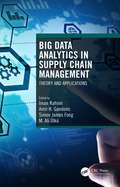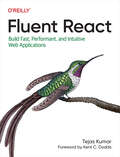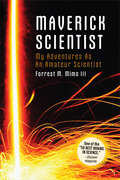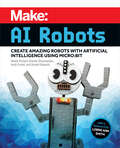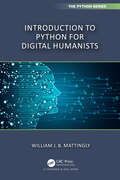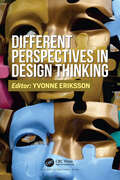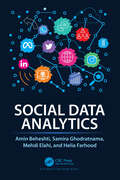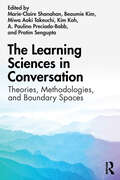- Table View
- List View
Digital Health: A Primer (Analytics and AI for Healthcare)
by Nilmini WickramasingheHealthcare systems globally are grappling with how best to implement effective and efficient patient-centred care while simultaneously trying to contain runaway costs and provide high quality. This book explores the essential enabling role of digital health, taking a socio-technical perspective and looking at the key facets of technology, people and process in turn.This book examines the opportunities of key digital health components, demystifying digital health and demonstrating how to use its key precepts effectively. The book presents evidence and anecdotes from stakeholders around the world, demonstrating the global relevance and the ability of digital health to uplift and upskill care delivery as it is applied commercially. Bridging academic theory and practice, this is a functional and accessible text for all digital health stakeholders.The text introduces critical issues and is suitable reading for students, practitioners and researchers in digital health and all healthcare-related domains.
Providing Integrity, Awareness, and Consciousness in Distributed Dynamic Systems
by Peter Simon SapatyThe ideas of this book originate from the mobile WAVE approach which allowed us, more than a half century ago, to implement citywide heterogeneous computer networks and solve distributed problems on them well before the internet. The invented paradigm evolved into Spatial Grasp Technology and resulted in a European patent and eight books. The volumes covered concrete applications in graph and network theory, defense and social systems, crisis management, simulation of global viruses, gestalt theory, collective robotics, space research, and related concepts. The obtained solutions often exhibited high system qualities like global integrity, distributed awareness, and even consciousness. This current book takes these important characteristics as primary research objectives, together with the theory of patterns covering them all. This book is oriented towards system scientists, application programmers, industry managers, defense and security commanders, and university students (especially those interested in advanced MSc and PhD projects on distributed system management), as well as philosophers, psychologists, and United Nations personnel.
The Sage Handbook of Online Higher Education
by Safary Wa-Mbaleka Kelvin Thompson Leni CasimiroThe SAGE Handbook of Online Higher Education presents a cutting-edge collection of 50 essays that explores the rapidly evolving landscape of online teaching and learning in higher education. Assembled and contributed by a team of leading experts, the Handbook adopts a uniquely holistic approach to examining the needs of online education. Chapters bring together voices from diverse and international backgrounds to provide insights applicable to a broad range of contexts, and present practical strategies for planning, delivering quality online higher education. The handbook covers a wide range of topics, including online pedagogy, instructional design, student engagement, technological innovation, assessment, leadership, and the developing role of online education in the context of broader societal and cultural shifts. The SAGE Handbook of Online Higher Education is an essential resource for educators, researchers, policymakers, and practitioners who seek to understand and shape the future of higher education in the digital age. Section 1: Fundamentals of Online Education Section 2: Online Education Around the World Section 3: Online Instructional Design Section 4: Online Instructional Delivery Section 5: Instructional Technology for Online Education Section 6: Online Education Administration and Management Section 7: Student Support Services
The Sage Handbook of Online Higher Education
by Safary Wa-Mbaleka Kelvin Thompson Leni CasimiroThe SAGE Handbook of Online Higher Education presents a cutting-edge collection of 50 essays that explores the rapidly evolving landscape of online teaching and learning in higher education. Assembled and contributed by a team of leading experts, the Handbook adopts a uniquely holistic approach to examining the needs of online education. Chapters bring together voices from diverse and international backgrounds to provide insights applicable to a broad range of contexts, and present practical strategies for planning, delivering quality online higher education. The handbook covers a wide range of topics, including online pedagogy, instructional design, student engagement, technological innovation, assessment, leadership, and the developing role of online education in the context of broader societal and cultural shifts. The SAGE Handbook of Online Higher Education is an essential resource for educators, researchers, policymakers, and practitioners who seek to understand and shape the future of higher education in the digital age. Section 1: Fundamentals of Online Education Section 2: Online Education Around the World Section 3: Online Instructional Design Section 4: Online Instructional Delivery Section 5: Instructional Technology for Online Education Section 6: Online Education Administration and Management Section 7: Student Support Services
Guide to Digital Innovation in the Cultural and Creative Industry (SAGE Works)
by Sunghan Ryu Yong Xiang Weimin ZhangThe digital age has brought significant changes to the cultural and creative industries, making it challenging to keep up with the latest trends. The Guide to Digital Innovation in the Cultural and Creative Industry is an informative resource that can help you navigate the revolution. It not only provides a comprehensive understanding of how digital transformation affects existing industries but also outlines emerging business opportunities. Whether you′re an experienced professional or a beginner, this book is an essential resource that will equip you with the knowledge and tools you need to succeed in the rapidly evolving landscape of the cultural and creative industries. Dive into: Democratizing creation: Discover how digital tools break down barriers and empower creators of all levels. From platforms to possibilities: Explore online video streaming, ebook publishing, virtual museums, and more, witnessing the rise of innovative business models. Cutting-edge tech, boundless potential: Delve into AI, blockchain, VR/AR, and other emerging technologies, understanding how they reshape content production, distribution, and consumption. Case studies that examine real-world scenarios, from the digital subscriptions of the New York Times to music consumption in the Spotify era.
Guide to Digital Innovation in the Cultural and Creative Industry (SAGE Works)
by Sunghan Ryu Yong Xiang Weimin ZhangThe digital age has brought significant changes to the cultural and creative industries, making it challenging to keep up with the latest trends. The Guide to Digital Innovation in the Cultural and Creative Industry is an informative resource that can help you navigate the revolution. It not only provides a comprehensive understanding of how digital transformation affects existing industries but also outlines emerging business opportunities. Whether you′re an experienced professional or a beginner, this book is an essential resource that will equip you with the knowledge and tools you need to succeed in the rapidly evolving landscape of the cultural and creative industries. Dive into: Democratizing creation: Discover how digital tools break down barriers and empower creators of all levels. From platforms to possibilities: Explore online video streaming, ebook publishing, virtual museums, and more, witnessing the rise of innovative business models. Cutting-edge tech, boundless potential: Delve into AI, blockchain, VR/AR, and other emerging technologies, understanding how they reshape content production, distribution, and consumption. Case studies that examine real-world scenarios, from the digital subscriptions of the New York Times to music consumption in the Spotify era.
Computer Network Time Synchronization: The Network Time Protocol on Earth and in Space, Second Edition
by David L. MillsCarefully coordinated, reliable, and accurate time synchronization is vital to a wide spectrum of fields—from air and ground traffic control, to buying and selling goods and services, to TV network programming. Ill-gotten time could even lead to the unimaginable and cause DNS caches to expire, leaving the entire Internet to implode on the root servers.Written by the original developer of the Network Time Protocol (NTP), Computer Network Time Synchronization: The Network Time Protocol on Earth and in Space, Second Edition addresses the technological infrastructure of time dissemination, distribution, and synchronization—specifically the architecture, protocols, and algorithms of the NTP. This system has been active in one form or another for almost three decades on the Internet and numerous private networks on the nether side of firewalls. Just about everything today that can be connected to a network wire has support for NTP.This book: Describes the principal components of an NTP client and how it works with redundant servers and diverse network paths Provides an in-depth description of cryptographic and other critical algorithms Presents an overview of the engineering principles guiding network configuration Evaluating historic events that have taken place since computer network timekeeping started almost three decades ago, the author details a number of systems and drivers for current radio, satellites, and telephone modem dissemination and explains how we reckon the time, according to the stars and atoms. The original 16 chapters of the first edition have been rewritten, updated, and enhanced with new material. Four new chapters cover new algorithms and previously uncovered concepts, including timekeeping in space missions.Praise for the first edition:"… For those that need an exhaustive tome on all of the minutiae related to NTP and synchronization, this is the source. … definitive … this book should be considered the last word on the topic."—Ben Rothke on Slashdot.org"… the bible of the subject… contains enough information to take you just as far as you want to go….Dr. Mills is the original developer of NTP."—Books On-Line
How to Stop a Hijacking: Critical Thinking in Civil Aviation Security
by Clay W. BilesHijackings and bombings have plagued civil aviation since 1930 and air rage incidents are on the rise. While there is aircraft and inflight training available for air marshals, other first responders receive minimal training on inflight security awareness and protocols. There are no other resources currently available to flight crews or armed first responders that specifically address inflight security and how to address threats of disturbances on airplanes.How to Stop a Hijacking provides readers with fundamental principles on how to think more critically about onboard security threats. The aircraft cabin poses unique environment and security challenges, and first responders can apply security awareness and critical thinking skills to establish a safer environment in the cabin and airport for everyone onboard. The lessons in this book are driven with the central objective of teaching the reader how to counter inflight aggression and maintain tactical control of the cabin. Written by a former federal air marshal instructor, this book looks at the recent rash of air rage incidents and violence on airplanes, in addition to the real and ever-present threat of hijack or potential explosive device.How to Stop a Hijacking is a practical guide that offers methodological and tactically proven strategies for stopping violent acts onboard an aircraft inflight.
Living the Lighting Life: A Guide to a Career in Entertainment Lighting
by Brad SchillerLiving the Lighting Life provides practical tools and advice for a successful career in entertainment lighting. This easy-to-navigate guide offers real-world examples and documentation from the author and key industry experts, giving readers a comprehensive overview of the lighting life. The book provides insight on: Different job opportunities in the entertainment lighting industry; Business procedures, contracts, time sheets, and invoices; Tips on self-promotion, networking, and continual learning; The lighting lifestyle, healthy living, and work-related travel; Maintaining and developing creativity to provide innovative lighting and solutions. With insightful interviews from industry veterans, Living the Lighting Life is a key navigational resource for anyone considering a career in entertainment lighting or just starting out.
Artificial Intelligence and Internet of Things: Applications in Smart Healthcare (Innovations in Big Data and Machine Learning)
by Lalit Mohan GoyalThis book reveals the applications of AI and IoT in smart healthcare and medical systems. It provides core principles, algorithms, protocols, emerging trends, security problems, and the latest e-healthcare services findings.The book also provides case studies and discusses how AI and IoT applications such as wireless devices, sensors, and deep learning could play a major role in assisting patients, doctors, and pharmaceutical staff. It focuses on how to use AI and IoT to keep patients safe and healthy and, at the same time, empower physicians to deliver superlative care.This book is written for researchers and practitioners working in the information technology, computer science, and medical equipment manufacturing industry for products and services having basic- and high-level AI and IoT applications. The book is also a useful guide for academic researchers and students.
Cultivating Professional Identity in Design: Empathy, Creativity, Collaboration, and Seven More Cross-Disciplinary Skills
by Monica W. Tracey John BaakiCultivating Professional Identity in Design is a nuanced, comprehensive companion for designers across disciplines honing their identities, self-perception, personal strengths, and essential attributes. Designers’ identities, whether rooted in education, workforce training, digital technology, arts and graphics, built environment, or other fields, are always evolving, influenced by any combination of current mindset, concrete responsibilities, team dynamics, and more. Applicable to designers of all contexts, this inspiring yet rigorous book guides practitioners and students to progress with ten key traits: empathy, uncertainty, creativity, ethics, diversity/equity/inclusion, reflection, learning, communication, collaboration, and decision-making.Though it details a complete journey from start to finish, this book acknowledges the varying paths of designers’ roles and is structured for a flexible, highly iterative reading experience. Segments can be read individually or out of order and revisited for new insights. Current and future stages of development – education experience, early-career opportunities, mid-career accomplishments, and/or career transitions – are factored in without hierarchy. Specific takeaways, activities, and reflection exercises are intended to work across settings and levels of experience. Design hopefuls and experts alike will find a new way to participate in and persevere through their work.
Using Cognitive and Affective Metrics in Educational Simulations and Games: Applications in School and Workplace Contexts (Routledge Research in Digital Education and Educational Technology)
by Harold F. O'NeilPresenting original studies and rich conceptual analyses, this volume explores how cognitive and affective metrics can be used to effectively assess, modify, and enhance learning and assessment outcomes of simulations and games used in education and training.The volume responds to the increasing use of computer-based simulations and games across academic and professional sectors by bringing together contributions from different research communities, including K-12 and postsecondary education, medical, and military contexts. Drawing on empirical results, the chapter authors focus on the design and assessment of educational simulations and games. They describe how quantitative and qualitative metrics can be used effectively to evaluate and tailor instructional resources to the cognitive and affective needs of the individual learner. In doing so, the volume enhances understanding of how games and simulations can intersect with the science of learning to improve educational outcomes. Given its rigorous and multidisciplinary approach, this book will prove an indispensable resource for researchers and scholars in the fields of educational assessment and evaluation, educational technology, military psychology, and educational psychology.
Advanced Instructional Design Techniques: Theories and Strategies for Complex Learning
by Jill E. StefaniakAdvanced Instructional Design Techniques provides comprehensive coverage of advanced topics in instructional design and development. This ideal resource for upper-level graduate coursework presents a thorough overview of theoretical foundations that support learning design beyond basic information processing and behaviorist principles, along with innovative strategies and problem-solving techniques to support designing for complex situations. Twelve wide-ranging chapters cover challenging topics such as needs assessment, sustainability, ethics, cognitive load, and more. Emphasizing reflective practice and decision-making in design environments, the book attends to the models and constructs that support context-specific instructional design across learning and training, from higher education and K-12 schooling to business and industry training to health care and public-sector services.
Beginner's Guide to Code Algorithms: Experiments to Enhance Productivity and Solve Problems
by Deepankar MaitraDo you have creative ideas that you wish you could transform into code?Do you want to boost your problem solving and logic skills?Do you want to enhance your career by adopting an algorithmic mindset?In our increasingly digital world, coding is an essential skill. Communicating an algorithm to a machine to perform a set of tasks is vital. Beginner’s Guide to Code Algorithms: Experiments to Enhance Productivity and Solve Problems written by Deepankar Maitra teaches you how to think like a programmer. The author unravels the secret behind writing code – building a good algorithm. Algorithmic thinking leads to asking the right question and enables a shift from issue resolution to value creation. Having this mindset will make you more marketable to employers. This book takes you on a problem-solving journey to expand your mind and increase your willingness to experiment with code. You will: Learn the art of building an algorithm through hands-on exercises Understand how to develop code for inspiring productivity concepts Build a mentality of developing algorithms to solve problems Develop, test, review, and improve code through guided experimentation This book is designed to develop a culture of logical thinking through intellectual stimulation. It will benefit students and teachers of programming, business professionals, as well as experienced users of Microsoft Excel who wish to become proficient with macros.
The Discipline of Data: What Non-Technical Executives Don't Know About Data and Why It's Urgent They Find Out
by Jerald SavinPulling aside the curtain of ‘Big Data’ buzz, this book introduces C-suite and other non-technical senior leaders to the essentials of obtaining and maintaining accurate, reliable data, especially for decision-making purposes. Bad data begets bad decisions, and an understanding of data fundamentals — how data is generated, organized, stored, evaluated, and maintained — has never been more important when solving problems such as the pandemic-related supply chain crisis. This book addresses the data-related challenges that businesses face, answering questions such as: What are the characteristics of high-quality data? How do you get from bad data to good data? What procedures and practices ensure high-quality data? How do you know whether your data supports the decisions you need to make? This clear and valuable resource will appeal to C-suite executives and top-line managers across industries, as well as business analysts at all career stages and data analytics students.
Reality Modeled After Images: Architecture and Aesthetics after the Digital Image
by Michael YoungReality Modeled After Images: Architecture and Aesthetics after the Digital Image explores architecture’s entanglement with contemporary image culture. It looks closely at how changes produced through technologies of mediation alter disciplinary concepts and produce political effects. Through both historical and contemporary examples, it focuses on how conventions of representation are established, maintained, challenged, and transformed. Critical investigations are conjoined with inquiries into aesthetics and technology in the hope that the tensions between them can aid an exploration into how architectural images are produced, disseminated, and valued; how images alter assumptions regarding the appearances of architecture and the environment.For students and academics in architecture, design and media studies, architectural and art history, and related fields, this book shows how design is impacted and changed by shifts in image culture, representational conventions and technologies.
Computational Framework for the Finite Element Method in MATLAB® and Python
by Pavel SumetsComputational Framework for the Finite Element Method in MATLAB® and Python aims to provide a programming framework for coding linear FEM using matrix-based MATLAB® language and Python scripting language. It describes FEM algorithm implementation in the most generic formulation so that it is possible to apply this algorithm to as many application problems as possible. Readers can follow the step-by-step process of developing algorithms with clear explanations of its underlying mathematics and how to put it into MATLAB and Python code. The content is focused on aspects of numerical methods and coding FEM rather than FEM mathematical analysis. However, basic mathematical formulations for numerical techniques which are needed to implement FEM are provided. Particular attention is paid to an efficient programming style using sparse matrices. Features Contains ready-to-use coding recipes allowing fast prototyping and solving of mathematical problems using FEM Suitable for upper-level undergraduates and graduates in applied mathematics, science or engineering Both MATLAB and Python programming codes are provided to give readers more flexibility in the practical framework implementation
Big Data Analytics in Supply Chain Management: Theory and Applications
by Iman Rahimi, Amir H. Gandomi, Simon James Fong, and M. Ali ÜlküIn a world of soaring digitization, social media, financial transactions, and production and logistics processes constantly produce massive data. Employing analytical tools to extract insights and foresights from data improves the quality, speed, and reliability of solutions to highly intertwined issues faced in supply chain operations.From procurement in Industry 4.0 to sustainable consumption behavior to curriculum development for data scientists, this book offers a wide array of techniques and theories of Big Data Analytics applied to Supply Chain Management. It offers a comprehensive overview and forms a new synthesis by bringing together seemingly divergent fields of research. Intended for Engineering and Business students, scholars, and professionals, this book is a collection of state-of-the-art research and best practices to spur discussion about and extend the cumulant knowledge of emerging supply chain problems.
Fluent React
by Tejas KumarWhen it comes to building user interfaces on the web, React enables web developers to unlock a new world of possibilities. This practical book helps you take a deep dive into fundamental concepts of this JavaScript library, including JSX syntax and advanced patterns, the virtual DOM, React reconciliation, and advanced optimization techniques. By becoming fluent in React, you'll quickly learn how to build better web applications.Author Tejas Kumar helps you explore the depths of React in plain English, without the typical software engineering jargon, so you can more easily understand how this JavaScript library works. You'll learn how to write intuitive React code that fully understands the nuances and layers of React, unlocking a whole new level of fluency.You will:Understand how React works at a deeper levelWrite React apps while optimizing them along the wayBuild resilient React applications that work well at arbitrary scaleCreate React applications for other platforms adjacent to the web and mobile devicesKnow when to reach for different mechanisms exposed by React, such as reducers versus state versus refs
Make: Maverick Scientist
by Forrest M. MimsMaverick Scientist is the memoir of Forrest Mims, who forged a distinguished scientific career despite having no academic training in science. Named one of the "50 Best Brains in Science" by Discover magazine, Forrest shares what sparked his childhood curiosity and relates a lifetime of improbable, dramatic, and occasionally outright dangerous experiences in the world of science.At thirteen he invented a new method of rocket control. At seventeen he designed and built an analog computer that could translate Russian into English and that the Smithsonian collected as an example of an early hobby computer. While majoring in government at Texas A&M University, Forrest created a hand-held, radar-like device to help guide the blind. And during his military service, he had to be given special clearance to do top secret laser research at the Air Force Weapons Lab. Why? Because while he lacked the required engineering degree, they wanted his outside-the-box thinking on the project.He went on to co-found MITS, Inc., producer of the first commercially successful personal computer, wrote a series of electronics books for Radio Shack that sold more than seven million copies, and designed the music synthesizer circuit that became known as the infamous Atari Punk Console. All this came before he started consulting for NASA's Goddard Space Flight Center, and NOAA's famous Mauna Loa Observatory, and earning the prestigious Rolex Award.This intimate portrait of a self-made scientist shares a revelatory look inside the scientific community, and tells the story of a lifelong learner who stood by his convictions even when pressured by the establishment to get in line with conventional wisdom. With dozens of personal photos and illustrations, Maverick Scientist serves as proof that to be a scientist, you simply need to do science.
Make: AI Robots
by Reade Richard Brenda Shivanandan Andy Forest Denzel EdwardsArtificial intelligence is a tool to explore and create, and it starts here with the experts at Steamlabs, a nonprofit that teaches teens to not just be users of technology, but to create with technology so they can be help shape our future.Make: AI Robots introduces young people to AI through exciting craft projects that start with a mechanical cardboard creation, integrates fun electronic lights and motors, adds simple coding on a micro:bit, and then teaches how to train AI to create a spark of life.With 32 projects designed to guide beginners through increasing challenges, Make: AI Robots is the perfect way to feed curious minds with fun AI experiments that will delight and inspire.
Introduction to Python for Humanists (Chapman & Hall/CRC The Python Series)
by William MattinglyThis book will introduce digital humanists at all levels of education to Python. It provides background and guidance on learning the Python computer programming language, and as it presumes no knowledge on the part of the reader about computers or coding concepts allows the reader to gradually learn the more complex tasks that are currently popular in the field of digital humanities. This book will be aimed at undergraduates, graduates, and faculty who are interested in learning how to use Python as a tool within their workflow. An Introduction to Python for Digital Humanists will act as a primer for students who wish to use Python, allowing them to engage with more advanced textbooks. This book fills a real need, as it is first Python introduction to be aimed squarely at humanities students, as other books currently available do not approach Python from a humanities perspective. It will be designed so that those experienced in Python can teach from it, in addition to allowing those who are interested in being self-taught can use it for that purpose.Key Features: Data analysis Data science Computational humanities Digital humanities Python Natural language processing Social network analysis App development
Different Perspectives in Design Thinking
by Yvonne ErikssonGlobalization and digitalization are buzz words in contemporary society. They affect both our private and our professional lives. Society has become more diverse with easier access to information and to virtual platforms that gives us opportunity to be in touch with colleagues, friends, family, etc. at any time. A complex environment is emerging wherein internet of things and big data are being integrated with products, production systems, healthcare, and daily activity and play an important part in decision making. This has an impact on future designs and the role of designers. Responsible designers with a holistic perspective are needed.The book highlights several aspects of design thinking such as Information Design and Critical Design. The meaning of culture, gender and disabilities are also discussed. The functions of Information Design are changing from ‘showing the way’, instruction manuals and graphic design. It will affect among others, healthcare technology, smart products and Industry 4.0. Design thinking perspective that includes users from the entire chain and from the producer to the end user of the product or service, is needed. This will also require gender and culture issues to be taken into consideration in designing products and services. Design thinking methods and critical aspects of design will contribute to an inclusive society.
Social Data Analytics
by Amin Beheshti Samira Ghodratnama Mehdi Elahi Helia FarhoodThis book is an introduction to social data analytics along with its challenges and opportunities in the age of Big Data and Artificial Intelligence. It focuses primarily on concepts, techniques and methods for organizing, curating, processing, analyzing, and visualizing big social data: from text to image and video analytics. It provides novel techniques in storytelling with social data to facilitate the knowledge and fact discovery. The book covers a large body of knowledge that will help practitioners and researchers in understanding the underlying concepts, problems, methods, tools and techniques involved in modern social data analytics. It also provides real-world applications of social data analytics, including: Sales and Marketing, Influence Maximization, Situational Awareness, customer success and Segmentation, and performance analysis of the industry. It provides a deep knowledge in social data analytics by comprehensively classifying the current state of research, by describing in-depth techniques and methods, and by highlighting future research directions. Lecturers will find a wealth of material to choose from for a variety of courses, ranging from undergraduate courses in data science to graduate courses in data analytics.
The Learning Sciences in Conversation: Theories, Methodologies, and Boundary Spaces
by Marie-Claire Shanahan Beaumie Kim Miwa Aoki Takeuchi Kim Koh A. Paulino Preciado-Babb Pratim SenguptaThe Learning Sciences in Conversation explores the unique pluralities, complex networks, and distinct approaches of the learning scientists of today. Focused on four key scholarly areas – transdisciplinarity, design, cognition, and technology – this cutting-edge volume draws on empirical and theoretical foundations to illustrate the directions, perspectives, methods, and questions that continue to define this evolving field. Contributions by researchers are put in dialogue with one another, offering an exemplary analysis of a field that synthesizes, in situ, various scholarly traditions and orientations to create a critical and heterogenous understanding of learning.
